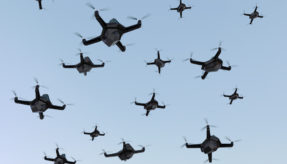
Writing for Defence Online, Mark Sugden, senior associate, and David Stanier, associate, in the Advanced Engineering group at European intellectual property firm, Withers & Rogers examine how innovative coatings can enhance the performance of naval vessels.
Materials science is focused on helping shipbuilders to find new ways to improve naval performance by increasing weapons load, while reducing fuel costs, maintenance and environmental impact.
Among the key areas of focus are high performance innovations, such as omniphobic coatings, which are currently being used in US Navy experiments.
The Ministry of Defence (MoD) recently released a report entitled ‘Defence in a competitive age’, which outlines how the UK’s armed forces should operate over the next few decades.
Instead of the traditional ‘boots on the ground’ approach, a focus on technological advancements has become a priority. By improving the versatility of equipment, for example, it can be used in different fields of operation, improving flexibility and reducing costs. Coatings are expected to play a central role, benefiting everything from tanks and warships to camouflage clothing.
As with most technologies under development, there have been incremental upgrades over the years to the equipment that the army relies upon. However, sometimes breakthroughs are made that provide a focus for R&D activity.
High performance coatings has emerged as a key innovation trend. Whether it’s adaptive camouflage that changes colour depending on its surroundings, or coatings that reduce the chance of radar detection, this niche field of scientific research and development could benefit a range of military applications.
Hydrophobic coatings have been used in the armed forces, particularly in a naval capacity, for many years. By repelling water, these materials can help to reduce the drag on boats, increasing speed and lowering fuel costs as a result.
However, while hydrophobic coatings repel water, they also attract other substances, which can stick to the boat’s surface, increasing drag and distorting radar signals as they accumulate.

Mark Sugden

David Stanier
Naval ships are often designed to reflect radar signals indirectly, to stop their specific location being revealed.
Any form of dirt or debris can affect this, making the vehicle light up like a beacon to those looking for it.
Omniphobic coatings could provide a practical and efficient solution to this problem.
By repelling multiple substances, omniphobic coatings can stop water, oil and even sea life from attaching to naval ships, as well as prevent scratching and denting.
Depending on the planned application, the coatings can also reduce the risk of radar distortion in a variety of fields of operation.
One patent pending (EP3167964 A1) omniphobic coating looks at a transparent self-healing coating, which is designed for use on boats to ensure that glass substrates on the windows remain clean.
Containing both oleophobic and hydrophobic characteristics, this innovative coating can improve onboard safety by keeping the windshield and any other windows free from residue.
The self-healing properties mean the coating lasts longer than standard solutions, without breaking down. This makes it ideal for use in even the most demanding climatic conditions.
Aside from omniphobic coatings, another area of innovation for the defence sector is ‘stealth’ coatings.
Patent number FR2720194 A1, describes an ionisable paint coating applied to the outer surface of the body of an aircraft, which not only absorbs radar waves, but protects against lightning.
Radar absorbing materials are often poorly resistant to the direct effects of lightning and can be destroyed when hit. This innovative coating ensures stealthy operations can continue even in stormy conditions.
While the patent focuses on aircraft usage, it’s likely that the coating could be adapted for naval and on-the-ground purposes.
In a similar vein, patent FR2716038 A1 covers a camouflage method, which protects against detection by electromagnetic means.
The vehicle, whether a boat, tank or plane, is coated with a material that inherently has a selective emittance, significantly disturbing the electromagnetic behaviour of the device.
This disturbance completely falsifies the information received by the detection means, keeping the vehicle’s location entirely unknown to outside observers.
High performance coatings, whether omniphobic or ‘stealth’, will be key to the future of military technology.
As a result, innovators in this area should seek patent protection early on, to secure a piece of the market share.
Providing 20 years of exclusivity, patents also offer the opportunity for businesses to benefit commercially from any sector crossover that occurs over the years.
Many defence sector innovations become relevant to the general public later on in their lifecycle, excellent examples being drones and satellite navigation, so it’s important to keep this in mind.
For an invention to be patentable it needs to be new and inventive, and this is based on all information that is publicly available before the patent application has been filed.
This is where keeping innovations in the defence industry confidential until a patent application has been filed can be a real asset.
Many similar innovations may never become publicly available, meaning the available scope of protection of the patent may be much greater than for innovations in other technology sectors.
Innovators are also urged to consider the UK’s Patent Box Scheme, which enables companies that have patented these innovative technologies to apply for a reduced rate of corporation tax of 10%.
The benefits of this scheme will be felt even more when the corporation tax rate increases to 25% in April 2023.
In rare cases, a secrecy order may be placed, temporarily or permanently, on a patent application if the UK Patent Office is concerned that publicly disclosing a technology might be ‘prejudicial to national security’.
In such cases, it is important to note that innovators can still take advantage of the UK’s Patent Box scheme. As long as the technology is ready for a grant, then it is eligible.
Securing patent protection allows applicants to commercialise their innovations and bring new products to market, while preventing competitors from copying them and potentially undercutting them on price.
It can also give a real advantage when applying to a tender, demonstrating expertise and exclusivity in the market.
The importance of IP in the defence industry is perhaps best summarised by the MOD, who state “for 70% of UK businesses, IP assets are more valuable than physical assets”.
If you would like to join our community and read more articles like this then please click here







